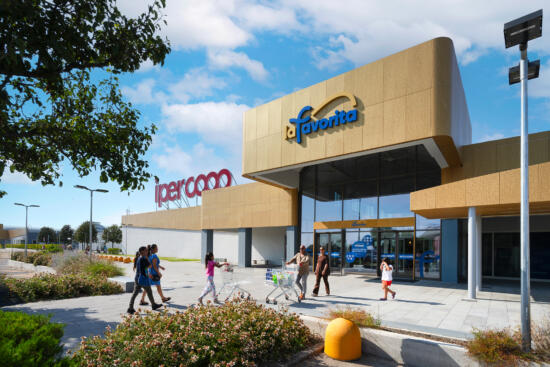With inflation and interest rates falling, the shopping center segment once again has interesting prospects

Now that the fear that shopping centers would not recover after Covid has been eliminated, different signals are emerging from various sources indicating a newfound interest in this type of asset, in part because of its ability to offer more attractive returns than other real estate segments.
We spoke about this with Roberto Zoia, IGD’s Director of Asset, Development and Network Management, as well as Chairman of the Consiglio Nazionale dei Centri Commerciali, (CNCC) who has always been a firm believer that shopping centers can continue to play a key role, even in light of the new consumer trends seen in the post-pandemic phase.
The most recent studies published about changes in real estate indicate that retail shopping centers are no longer the sector’s Cinderella. What metrics show that the trend has changed with respect to the recent past?
There are numerous and very clear signals. The first is the fact that tenants’ sales continue to grow, surpassing pre-Covid levels in the year that just ended.
A study carried out by CNCC and EY involving 300 properties with about 10 thousand points of sale distributed throughout Italy, showed that turnover in 2023 was better not only compared to 2022, but also compared to 2019, the last year not penalized by the pandemic. A dynamic which is also confirmed by the convincing sales posted by the retailers in IGD’s centers in the year that just ended.
The CNCC-EY report also notes a continuous improvement in footfalls in Italy with dynamics which indicate that 2019 levels can be recovered in 2024, a plausible result which has already been achieved by a few individual shopping centers in 2023, including by IGD portfolio assets.
CBRE’s latest study, which analyzes the retail segment’s performance in the fourth quarter of 2023, focuses on the underlying reasons as to why the gap between current footfalls and the average levels seen in 2019 has yet to be closed: according to this analysis, high inflation negatively impacts the frequency of purchases, but overall spending is higher.
The mini-trend observed in recent months, with footfalls picking up as inflation slows, suggests that in an environment of disinflation, in 2024 visits to shopping malls could actually become more frequent.
We are, moreover, in an environment where the confidenc of consumers and commercial businesses is improving. The volume of investment in Italy in the sector finally picked up in the last quarter of 2023, even if, for the time being, the transactions have largely been opportunistic.
To complete the picture of the metrics reflecting the health of our sector, CBRE’s numbers for the fourth quarter of 2023 show a prime shopping center yield that reached 6.75%, an increase of 10 basis points against the previous quarter.
After the deep repricing seen in recent years, at current net initial yields, shopping centers now provide the highest returns of all the other asset classes.
For investors seeking returns, therefore, retail represents an opportunity that should be taken into consideration.
Will retail continue to be an interesting segment going forward?
Let us start with a more general consideration in order to properly frame the retail outlook. As a whole, the European real estate market is expected to recover in the wake of the last few years during which it suffered: CBRE’s Outlook 2024, for example, indicates that although repricing is still ongoing, investment is expected to pick up.
A global market environment like the one expected to be seen in the second half of the year, with inflation and interest rates falling, bodes particularly well for the shopping center sector.
While the real estate sector in general was adversely impacted by a high cost of money over the past two years, the retail segment, as we have seen, was also affected by the impact that higher prices had on consumption, which affected household spending. As the 2% inflation target gets closer and monetary tightening eases, the retail segment will clearly benefit.
So there is a consensus today that retail, along with hotels, is the sector with the best prospects in Italy.
Can you give us an idea about scenarios for other types of assets?
Logistics, after a period of strong demand and continued interest, looks set to maintain its appeal, even if the margins will no longer be what they were in the past.
The office segment, on the other hand, appears to have the most uncertain outlook: in a study published in July 2023, McKinsey predicts that hybrid work policies will erase $800 billion in value from office buildings in major cities around the world by 2030. What is certain is that in the next few years we will be undergoing a profound rethinking of the size and allocation of workspaces.
What will be the impact of the new scenario on IGD’s real estate assets?
After years in which we continued to invest in the quality and sustainability of our assets, today we see the opportunity for the hard work completed with determination, even in difficult times, to be valued.
One outcome we are focusing on is to stabilize real estate valuations as soon as possible, given the sizeable negative impact that high interest rates have had on fair value over the past three semesters.
2024 could be the breakthrough year.
In the retail shopping center sector, particularly in the second half of the year, we expect to see a revival in “core” investments: investments, therefore, different from the opportunistic transactions we have seen recently.
I believe that the next few months will be crucial. We have to see whether or not we really will have a recovery in investment and whether monetary policy continues to ease, resulting in lower interest rates. These two factors, along with the resilient performance of shopping centers, may lead to a leveling off of cap rates, resulting in stable fair value valuations of assets which will also have a positive impact on Loan-to-Value.
Share




